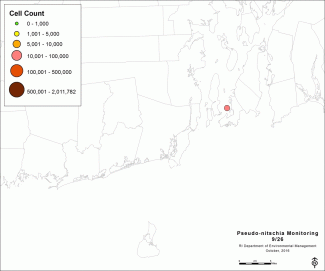Rhode Island’s October 2016 Pseudo-nitzschia Bloom
Evidence of a 2016 Pseudo-nitzschia bloom in Rhode Island’s coastal waters was first discovered on September 26th when results of routine plankton sampling conducted as part of RIDEM’s ambient shellfish water quality monitoring detected an elevated Pseudo-nitzschia cell count (28,731 cells/L) in outer Newport Harbor.
Subsequent phytoplankton sampling in mid- Narragansett Bay (between Jamestown and Prudence Island) on October 5th and 6th revealed extremely elevated cell counts and one location also tested positive for the presence of Domoic Acid (DA) (the toxin that can be produced by Pseudo-nitzschia cells that causes Amnesiac Shellfish Poisoning) utilizing the Scotia screening kit. These results led RIDEM in consultation with RIDOH to put in place the unprecedented Harmful Algal Bloom (HAB) shellfish closure for all of Narragansett Bay, Sakonnet River and Mt Hope Bay effective sunrise on October 7th and to require that dealers hold all shellfish in their possession.
These results also set off the first round of shellfish meats collected for testing the presence of Domoic Acid, and additional phytoplankton sampling to measure cell counts and to screen for Domoic Acid. Over the course of the next several days, multiple shellfish samples (quahogs, mussels, whelk, and oysters) were collected from Shellfish Harvest Tagging Areas 4A, 3W, and 1B – all of which tested negative for the presence of Domoic Acid. These results led to the Oct 10th release of shellfish held in dealers’ stock.
Over the course of the next several weeks, RIDEM undertook an intensive phytoplankton sampling and shellfish meats collection program – completing a total of 16 plankton and 15 shellfish surveys with 176 plankton samples and 57 shellfish samples analyzed (approximately 150 samples were tested for domoic acid). The results of these surveys in the second week of October showed improving conditions with declining cell counts and absence of domoic acid toxicity - leading to the October 15th re-opening of all waters impacted by the HAB related shellfish harvesting closure (conditional areas closed due to rainfall reopened at noon on October 17th).
The roller coaster nature of the HAB bloom, however led to the October 20th closure of the lower Sakonnet River resulting from elevated cell counts and positive toxicity in plankton detected offshore of Sakonnet Point and toxicity detected in shellfish collected from Sakonnet Harbor. Similar plankton results detected at locations off Easton’s Bay and West Passage, and the presence of toxins in mussels collected at Fort Wetherill led to extending the closure on October 21st to include lower East Passage and lower West Passage (Pt Judith to Sakonnet Point).
As quickly as the cell counts had risen in the lower Bay, they declined. Along with negative results for Domoic Acid in plankton and shellfish collected in various locations in the affected areas, these results led to the re-opening of all areas closed due to the HAB bloom effective sunrise on October 29th. Throughout the closure, shellfish from open areas were tested and found absent of toxins, assuring the safety of shellfish in the market. Also the testing of whelk detecting no toxicity present allowed for the ban on whelk harvesting to be lifted on October 26th.
Throughout Rhode Island’s HAB bloom, only 4 locations (two mid-Bay and two off-shore) tested positive for toxicity in plankton samples and only 2 locations tested positive for toxicity in shellfish meats (Ft. Wetherill and Sakonnet Harbor). Domoic acid levels in shellfish at these locations were far below the National Shellfish Sanitation Program established threshold of 20 ug/g that triggers a mandatory closure. For this reason, Rhode Island’s HAB related shellfish closures are considered precautionary.

